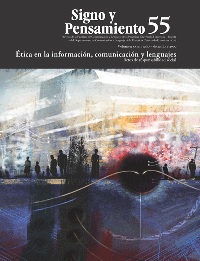Abstract
In this article we present the results of research work on the role played by folk music in the municipality of Villa Rica (Cauca, Colombia). Thus, we describe three different social contexts (during the Christmas celebrations of Nativity, during children and adults’ wakes, and both at the workplace and/or during recreational activities) where folk music is performed, plus two entrepreneurial projects related to music performance in the aforementioned contexts. Based on Pierre Bourdieu’s theories on cultural production, our text basically argues that there are intermediate zones where the “logics” common to the two different sub-fields merge together via the social agents involved in the activities.
Aprile, J. (1994), Los pueblos de negros caucanos y la fundación de Puerto Tejada, Cali, Gobernación del Valle del Cauca.
Aristizábal, M. (2005), “Las fiestas de ‘adoración al niño’ en Quinamayó-Colombia. ¿Evidencia de resistencia cultural o estrategia política para ganar reconocimiento?”, en Conferencia en Coloquio idymov ‘Construir y vivir la diferencia. Los actores de la multiculturalidad en México y Colombia’, México, CIESAS-IRD-ICANH-CEMCA-CREDAL.
Arocha, J. (1995, junio), “Unidades de producción nortecaucanas (Colombia): modernización y funcionamiento”, en América Negra, núm. 9, Pontificia Universidad Javeriana.
Atencio, J. y Castellanos, I. (1982), Fiestas de negros en el norte del Cauca: las adoraciones del Niño Dios, Cali, Universidad del Valle.
Bermúdez, A. (1997), “Cimarronismo, costumbre y cultura en Puerto Tejada”, en Zuluaga, F. y Valencia, A. (ed.), Puerto Tejada 100 años, Puerto Tejada, Alcaldía Municipal.
Booth, G. D. y Kuhn, T. L. (1990), “Economic and Transmission Factors as Essential Elements in the Definition of Folk, Art, and Pop Music”, The Musical Quarterly, vol. 74, núm. 3, pp. 411-438.
Bourdieu, P. (1995), Las reglas del arte. Génesis y estructura del campo literario, Barcelona, Anagrama.
Caicedo, M. (2003), “Descomposición de la economía campesina y condición de la mujer en el norte del Cauca”, en Anuario de Investigaciones, núm. 3, Facultad de Ciencias Sociales y Económicas, Universidad del Valle.
Colmenares, G. (1983), Cali: terratenientes, mineros y comerciantes (Siglo XVIII), Bogotá, Banco Popular.
De Garay, A. (2000), “La glocalización de la producción y el consumo cultural en México” [en línea], disponible en http://www.hist.puc.cl/historia/iaspm/actas.htm, recuperado: 10 de noviembre de 2005.
De Roux, G. y Yunda, A. C. (2001, octubre), “Procesos, políticas y coyunturas regionales y sus efectos sobre el campesinado”, en Anuario de Investigaciones, núm. 1, Facultad de Ciencias Sociales y Económicas, Universidad del Valle.
Díaz de Zuluaga, Z. (1983), Guerra y economía en las haciendas: Popayán 1780-1830, Bogotá, Banco Popular. Ellmeier, A. (2003), “Cultural Entrepreneurialism: on the Changing Relationships Between the Arts, Culture and Employment”, en The International Journal of Cultural Policy, vol. 9, núm. 1, pp. 3-16.
Jaramillo Uribe, J. (2001), Ensayos de historia social, Bogotá, Ceso, Uniandes, Banco de la República, Icanh, Colciencias, Alfaomega.
Lewis, G. (2005), “Dirt Roads and White Lines: Identity and Place in the Country Sound of the Other California”, en The Journal of Popular Culture, vol. 38, núm. 5.
Martin, P. (1995), Sounds and Society: Themes in the Sociology of Music, Manchester, MU Press.
Meintjes, P. (1990), “Paul Simon’s Graceland, South Africa, and the Mediation of Musical Meaning”, en Ethnomusicology, vol. 34, núm. 1, pp. 37-73.
— (2003), Sound of Africa! Making Music Zulu in a South African Studio, Durham, Duke University Press.
Mina, M. (1975), Esclavitud y libertad en el valle del río Cauca, Bogotá, Ediciones La Rosca.
Palau Valderrama, P. (2007), Bombarra, tuba y helicón: música tradicional de las adoraciones del niño Dios en el norte del Cauca y sur del Valle [tesis de maestría], Cali, Universidad del Valle, Facultad de Artes Integradas, Maestría en Música con énfasis en Musicología.
Portes de Roux, H. (1986a), “Las adoraciones nortecaucanas del Niño Dios: un estudio etnomusicológico” [inédito].
— (1986b), “Música religiosa de negros nortecaucanos en las voces de las cantoras de Mingo” [lp], Universidad del Valle, Fundación para la Promoción de la Investigación y la Tecnología, Banco de la República.
Rasmussen, L. (1995), “From Source to Commodity: Newly-Composed Folk Music of Yugoslavia”, Popular Music, vol. 14, núm. 2, pp. 241-256.
Sevilla, M. (2008), “La música del país vallenato: Acuerdos y divergencias en torno a los símbolos musicales de identidad”, en Pereira González, J. M.; Villadiego Prins, M., y Sierra Gutiérrez, L. I. (eds.), Industrias culturales, músicas e identidades. Una mirada a las interdependencias entre medios de comunicación, sociedad, cultura, Bogotá, Editorial Pontificia Universidad Javeriana.
Urrea, F. y Hurtado, T. (1997), “Puerto Tejada: de núcleo urbano de proletariado agroindustrial a ciudad dormitorio”, en Zuluaga, F. y Valencia, A. (ed.), Puerto Tejada 100 años, Puerto Tejada, Alcaldía Municipal.
Wade, P. (2000), Music, Race and Nation: música tropical en Colombia, Chicago, University of Chicago Press.
— (1998), “Music, blackness and national identity”, en Popular Music, núm. 33, pp. 47-72.
This journal is registered under a Creative Commons Attribution 4.0 International Public License. Thus, this work may be reproduced, distributed, and publicly shared in digital format, as long as the names of the authors and Pontificia Universidad Javeriana are acknowledged. Others are allowed to quote, adapt, transform, auto-archive, republish, and create based on this material, for any purpose (even commercial ones), provided the authorship is duly acknowledged, a link to the original work is provided, and it is specified if changes have been made. Pontificia Universidad Javeriana does not hold the rights of published works and the authors are solely responsible for the contents of their works; they keep the moral, intellectual, privacy, and publicity rights.
Approving the intervention of the work (review, copy-editing, translation, layout) and the following outreach, are granted through an use license and not through an assignment of rights. This means the journal and Pontificia Universidad Javeriana cannot be held responsible for any ethical malpractice by the authors. As a consequence of the protection granted by the use license, the journal is not required to publish recantations or modify information already published, unless the errata stems from the editorial management process. Publishing contents in this journal does not generate royalties for contributors.


